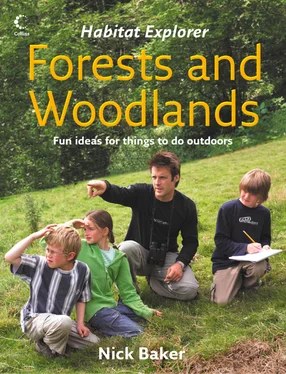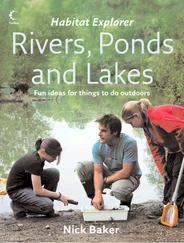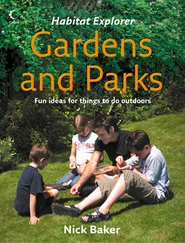For my wild friend Ceri, a small token of my appreciation of you. You saved me!
Cover
Title Page
Dedication
The wildlife in woodland The wildlife in woodland Looking up through the bright green, newly unfurled leaves of a beech woodland, you may feel like you are in a huge cathedral gazing up through the stained glass windows – ones that are made up of many shades of green. But we chop these trees down, use them as crops or as things to climb. Woodlands are places to walk the dog, they form barriers and boundaries but they are the lungs of the planet. Trees are amazing light machines. Just like other plants, they trap the Sun’s energy by using it to combine water and carbon dioxide gas in the air to form sugars. But trees do it on a much bigger scale. Each one is a light factory, with tiny microscopic work stations inside each leaf. While looking up through the canopy, hold a leaf in your hand and imagine the scale of production. Think of the millions of little cells in the leaf and then multiply by the number of leaves you can see all around you. Just half a hectare of woodland is such an effective factory that it produces over 6,000 tonnes of roots, wood and leaves every year! To smaller beasts, a field of grass is like a forest, but a forest, wood or copse is a unique experience for human-sized creatures. This is exactly what this book is about: exploring our woods, forests, hedgerows and some of the habitats that are associated with them. The book is divided into chapters that roughly reflect the different levels of woodland. Imagine the woodland as if it was a layer cake. If you were able to take a slice through it, you would see a pattern to the apparent tangled mass of life.
Handy stuff for exploring with
The tree canopy
Is your wood ancient?
Keep a tree log
Make leaf lace
The texture of bark
How old is your tree?
Profiling your tree
Whistling in the wood
Grow your own giant
The understorey
Budding brilliant
Mapping territories
Talk with the birds
Nests and holes
Make your own nest
Hedge your bets
Seed watching!
The herb layer
See the light
Rabbit hunting
How to hide yourself
Brock watch
Know your cones
Spore points
The litter layer
Signs and reading them right
Nuts - who has nibbled them?
The fungus among us
Boring beetles
Galling
Little jumpers
Going further
Index
Author’s Acknowledgements
Keep Reading
Copyright
About the Publisher
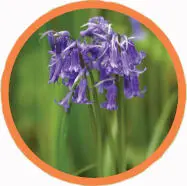
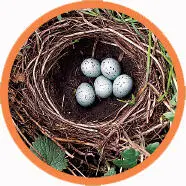
Looking up through the bright green, newly unfurled leaves of a beech woodland, you may feel like you are in a huge cathedral gazing up through the stained glass windows – ones that are made up of many shades of green. But we chop these trees down, use them as crops or as things to climb. Woodlands are places to walk the dog, they form barriers and boundaries but they are the lungs of the planet.
Trees are amazing light machines.Just like other plants, they trap the Sun’s energy by using it to combine water and carbon dioxide gas in the air to form sugars. But trees do it on a much bigger scale. Each one is a light factory, with tiny microscopic work stations inside each leaf. While looking up through the canopy, hold a leaf in your hand and imagine the scale of production. Think of the millions of little cells in the leaf and then multiply by the number of leaves you can see all around you. Just half a hectare of woodland is such an effective factory that it produces over 6,000 tonnes of roots, wood and leaves every year!

To smaller beasts, a field of grass is like a forest,but a forest, wood or copse is a unique experience for human-sized creatures. This is exactly what this book is about: exploring our woods, forests, hedgerows and some of the habitats that are associated with them.
The book is divided into chaptersthat roughly reflect the different levels of woodland. Imagine the woodland as if it was a layer cake. If you were able to take a slice through it, you would see a pattern to the apparent tangled mass of life.
Handy stuff for exploring with
As a youthful naturalist with, I assume, little pocket money,you will be relieved to know that when it comes to specialist equipment, there really isn’t much needed! Most can be put together and constructed or improvised from items found under the sink, in the shed or under the stairs. In fact, the most important tools you need to learn to use are your own senses; but more about that later. For now, though, here is a short list of things that I find useful in an everyday kind of way when exploring woodland.
Bamboo canesThese are handy things for many of the activities in this book and they are useful for creating an extention to your arms! You can tape a wire hook to the end and use it to bend down branches that were otherwise out of your reach or use it to beat branches that are in your way.
Binoculars and magnifying lensAnything with a lens in it to magnify little things or bring distant subjects closer is going to be a relatively expensive bit of kit compared with the rest of the equipment you might have with you. But if you can possibly afford it, they are really worth investing in and there are many different kinds at prices to suit all sizes of pocket.
Clear plastic containersThese can be anything from purpose-made specimen tubes to old 35mm film canisters and empty jam jars. They are handy for collecting and observing specimens in. Plastic bags are also very useful and have the added advantage of being lightweight and folding flat in your pocket.
Field guidesAlways handy, but if you take good notes, they can be consulted once you have got home and so save you space in your pockets or your day pack.
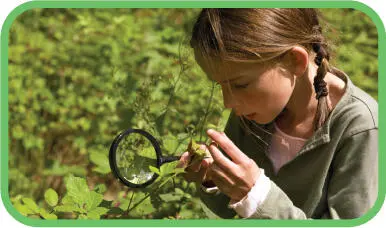
Gaffer tapeMany of the things you build or construct in this book use this wonderful stuff. It is also excellent for making repairs and quick fixes.
Pen and paper (notebook)It is a very useful skill to record your observations, never mind how seemingly insignificant they may be. All the best naturalists do it.
SieveUseful for panning through leaf litter and soil. This is one of the best ways to find the over-wintering pupae of many moth species.
Back packFinally, you need something to put all this stuff in! Make sure it’s large enough to carry everything, but that it’s not so heavy it spoils a day out in the woods.
A tree on its own is never a tree on its own. Trees act like a life magnet. You can have a plain bare patch of grass with nothing much in the way of wild life hanging around. But stick a tree in the middle of it and it’s a whole different story. Birds will perch in it and may nest there, insects will find it attractive and nibble or even breed in it. As the tree gets bigger, it creates more living space for even more life.
Читать дальше
